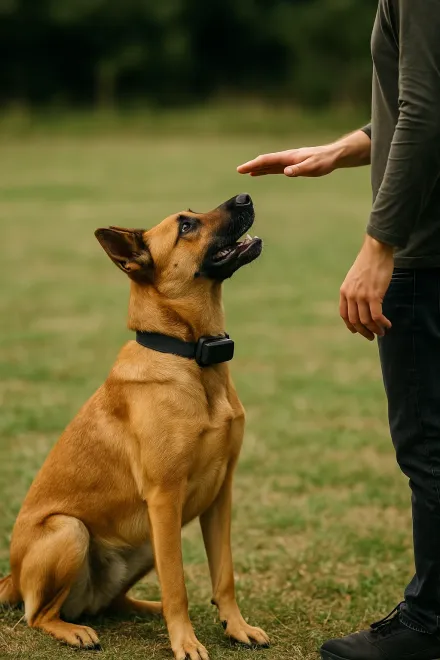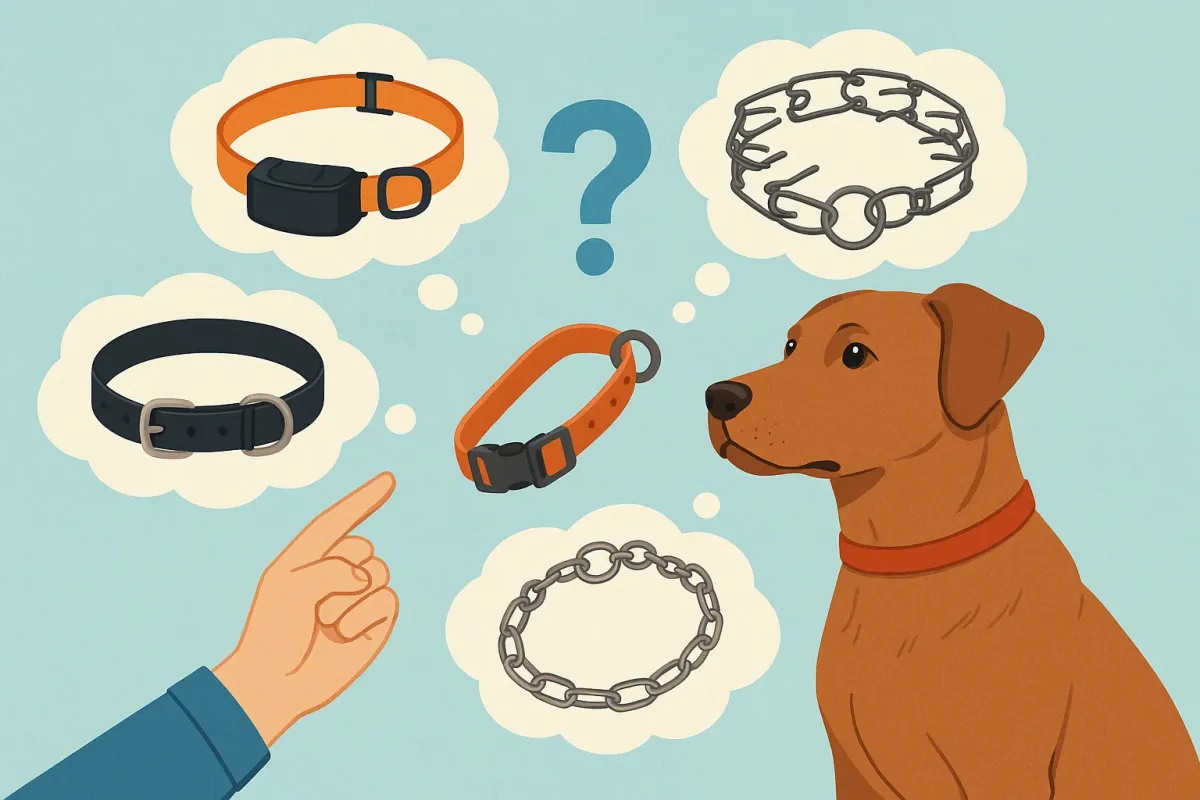
Choosing the right training collar is one of the most important decisions in a dog's education. It's not just a tool: a good collar can improve communication, reinforce commands, and help correct behaviors in a safe and respectful way. However, using the wrong model can create confusion, stress, or even rejection of the training process.
As a canine behavior specialist, I always recommend analyzing your dog's temperament, size, and sensitivity level before choosing a collar. In this guide, I'll show you how to select the model that best fits your companion, when to use it, and which mistakes to avoid so you can achieve real, long-lasting results without compromising their well-being.

What is a training collar and what is it for?
A training collar is a tool designed to improve communication between the dog and their handler. Unlike a conventional collar, this type of device allows you to correct unwanted behaviors and reinforce basic commands through gentle, controlled stimuli such as vibrations, sounds, or static impulses.
Its goal is not to punish, but to guide the dog and help them associate commands with the correct behavior. When used properly, it can speed up the learning process, especially in dogs with a strong temperament or in environments with many distractions.
There are different models tailored to each need, from vibration collars to long-range systems for hunting dogs. In our training collars guide you'll find a complete comparison of the most recommended types and their uses.
Types of training collars: which one to choose for your dog
There are different types of training collars, and each one serves a specific purpose. Choosing the most suitable option depends on the dog's temperament, size, level of obedience, and the type of training you plan to do. Good training isn’t about force or punishment; it’s about communication, positive reinforcement, and the smart use of available tools.
Electric shock or static-stimulation collars
Electric shock collars, also known as static-stimulation collars, emit a small adjustable current that helps capture the dog's attention at the exact moment an unwanted behavior occurs. When properly calibrated and used judiciously, they do not cause pain but rather a mild sensation that helps the dog associate the command with the correction.
These models usually include several intensity levels and alternative modes, such as vibration or sound, to adapt training to the animal's sensitivity. They are especially useful for large, stubborn dogs or in contexts where remote control is necessary, such as advanced obedience training or hunting.
Use must be responsible: do not apply continuous shocks or use them as punishment, but as a precise communication tool. Results are excellent when combined with verbal commands, positive reinforcement, and short, consistent sessions.
Vibration or sound collars
Vibration or sound collars are a gentler, more respectful alternative. Instead of delivering electrical impulses, they generate a slight vibration or a beep to get the dog's attention. They are perfect for sensitive dogs or owners who prefer non-electric methods.
These collars are very effective for teaching basic commands, correcting distractions, or urban training. In addition, some models combine vibration and sound, allowing the dog to learn to respond to different signals depending on the situation.
Their main advantage is that they reduce the risk of fear or stress, promoting calm, positive learning. However, they require consistency, patience, and good timing from the handler to achieve lasting results.
Calming pheromone collars
Pheromone collars aren’t intended for training per se, but rather as complementary support in cases of anxiety, fears, or stress. They release a synthetic substance similar to the pheromone mothers emit after giving birth, which conveys a sense of calm and security to the dog.
They are highly recommended for dogs that show nervousness, noise sensitivity, or anxious behaviors, and they can be perfectly combined with other training methods. They don’t directly correct a behavior, but they help stabilize the dog’s emotional state, improving focus and willingness to learn.
Collars for hunting dogs
Training collars for hunting dogs are designed to work over long distances. They often incorporate advanced features such as GPS tracking, radio-frequency control, or different stimulus modes. These tools are essential for maintaining safety and obedience in open environments or during tracking.
These devices allow you to send commands remotely without raising your voice or losing control of the animal, which improves effectiveness and coordination in the field. Their use requires proper configuration and prior training so the dog associates each signal with a specific command.
Collars from recognized brands like Meloive
Specialized brands like Meloive offer models that combine technology, ergonomics, and safety. These collars stand out for durability, precise stimulus levels, and high-quality materials. They also typically include energy-saving systems, LCD screens, and multifunction remote controls.
Opting for a recognized brand ensures better intensity control, improved skin contact design, and a more stable response during training. They’re the favorite choice of professional trainers and demanding owners who seek results without compromising the animal’s welfare.
Comparison of the main types of training collars
The table below summarizes the most important features of each collar type, their advantages, limitations, and the dog profile they’re recommended for:
| Collar type | Advantages | Disadvantages | Effectiveness level | Ideal for |
|---|---|---|---|---|
| Electric shock or static stimulation | High precision, remote control, multiple intensity levels | Requires experience; misuse can cause stress | Very high | Large, hunting, or strong-tempered dogs |
| Vibration or sound | Gentle, safe, no electrical stimuli | Less effective for very distracted or stubborn dogs | Medium–high | Small or sensitive dogs; urban training |
| Calming pheromones | Reduces anxiety, non-invasive, ideal complement | Does not directly correct behaviors | Medium | Nervous, anxious, or newly adopted dogs |
| Hunting dogs | Great range, precision, GPS and remote features | More expensive, requires technical training | Very high | Hunting dogs or field work |
| Brands like Meloive | High quality, ergonomics, precise control, durability | Higher price than generic models | Very high | Demanding owners and professional trainers |
Ultimately, choosing the collar type should always be based on the dog’s well-being and the training goal. There is no one-size-fits-all model: every dog is different, and the right tool is the one that adapts to their temperament, size, and learning style. Before deciding, it’s wise to research thoroughly, pick a trusted brand, and—if possible—seek guidance from a canine behavior professional.
Recommendations before using a training collar
Before using any training collar, it’s essential to understand how it works and make sure it’s used responsibly. Improper handling can create fear or stress in the dog, while correct use facilitates learning and strengthens the bond between handler and pet.
Key tips before you start
- Don’t use it without knowing how it works: read the manual and be sure you understand the available modes and intensity levels before applying it.
- Introduce the collar gradually: let the dog get used to wearing it without activating it for the first few days.
- Don’t use it as punishment: the goal is to correct and guide, not to frighten or cause pain.
- Always supervise the first sessions: watch the dog’s reactions and adjust intensity according to their sensitivity and behavior.
- Consult a professional: if the dog shows anxiety, fear, or aggressive behavior, seek help from a trainer or ethologist.
Following these recommendations not only ensures the dog’s safety, but also improves training effectiveness. Patience, consistency, and empathy are key to achieving lasting, positive results.
Common mistakes when choosing or using a training collar
Even with the best intentions, many owners make mistakes when using a training collar. These errors often stem from a lack of information or incorrect application of the tool, which can reduce its effectiveness and even create rejection or stress in the dog.
- Using the collar without reading the instructions: each model works differently, and understanding its modes and intensities is essential for safe use.
- Not adjusting intensity correctly: stimulation that’s too low may be ineffective, while excessive intensity can cause discomfort or fear.
- Choosing the wrong size: a collar that’s too loose or too tight prevents proper skin contact and can cause chafing or reduce effectiveness.
- Using it all day long: the collar should be removed after training sessions to avoid irritation or unnecessary discomfort.
- Not pairing it with positive reinforcement: successful training depends on a combination of correction and reward; it should never rely solely on the stimulus.
Avoiding these mistakes ensures more effective, respectful, and safe training. The key is to understand that the collar is just a tool within a broader educational process where communication and empathy are fundamental.
Pros and cons of using training collars
Training collars can be very useful tools when used correctly, but they can also create problems if applied without knowledge or supervision. Like any educational resource, their effectiveness and safety depend on how wisely they’re used.
Among their main advantages are precise communication with the dog and the ability to work at a distance, especially in open spaces or with very active breeds. However, improper use can cause stress, fear, or confusion, negatively affecting the relationship between handler and animal.
Therefore, before choosing one, it’s worth weighing the pros and cons and ensuring the collar will be used as support within a positive and respectful training process.
Frequently asked questions about dog training collars
From what age can a training collar be used?
Ideally, only on dogs over 6 months old that already understand basic commands. In puppies, the nervous system and behavior are still developing, so it’s better to start with positive reinforcement and basic obedience before introducing any type of training collar.
Do training collars hurt the dog?
No, as long as they’re used correctly. Modern models allow you to adjust intensity or use vibration or sound modes. The goal isn’t to cause pain, but to capture the dog’s attention to redirect their behavior. In contrast, improper or abusive use can indeed create stress or fear.
How long should a training collar be used each day?
It’s not recommended to leave it on all day. Ideally, use it only during training sessions, which should last between 10 and 20 minutes. Afterwards, the collar should be removed to avoid irritation or negative associations.
What type of collar is best for beginners?
The vibration or sound collars are the most recommended for those starting out. They’re gentle, safe, and allow you to teach basic commands without using electrical stimuli, while keeping a positive approach.
Can I use the training collar together with a harness?
Yes, it’s possible, but each tool serves a different purpose. The harness is for walks and physical control, while the training collar is an educational aid. They shouldn’t be attached to the same leash or used simultaneously for pulling the dog.
What should I do if my dog gets scared or doesn’t respond well to the collar?
Stop using it immediately and check whether the intensity or mode chosen is appropriate. Sometimes it’s enough to lower the stimulation or switch to a gentler mode, such as vibration. If the dog shows persistent fear, it’s advisable to consult a canine trainer or ethologist before continuing.



